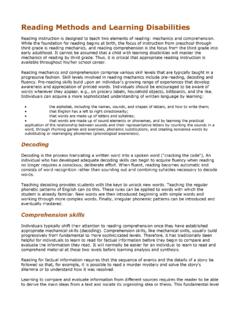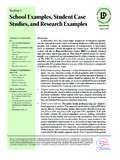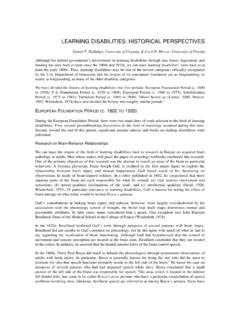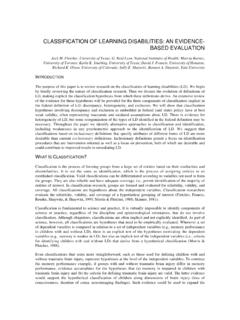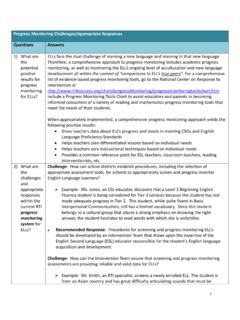Transcription of Section 4 Fidelity of Implementation - LDAofKY
1 Section 4. Fidelity of Implementation August 2006. What is Fidelity of Overview Implementation ? page One reason for the emphasis on changes to specific learning disabilities (SLD) identification procedures in the Individuals with Disabilities Education Why is Fidelity of Implementation Improvement Act of 2004 ( 108-446) (IDEA 2004) is the perception that Important? page problems with the current assessment tools result in a number of problems with eligibility decisions: How Can Schools The aptitude-achievement discrepancy method represents a wait-to-fail Ensure Fidelity of model. Implementation ? page The discrepancy definition contains variability. High Fidelity in Tier 2 and Assessment tools do not provide data that inform service delivery. Beyond, page Use of one data point lacks reliability and validity. Inappropriate instruction lacks formal prereferral documentation.
2 Changing Structures, IDEA 2004 allows state educational agencies (SEAs) and local educational Roles, and Responsibilities, agencies (LEAs) to consider a student's responsiveness to intervention (RTI) as page one component of SLD determination. RTI is thought to address several of the Methods and Procedures shortcomings noted in past approaches to SLD identification. (Activities/Tools), page As presented in our Getting Started with SLD Determination: After IDEA. Reauthorization manual (Getting Started with SLD Guide), improvements to Activity : Essential Task List for Fidelity of the method of SLD identification represent only one facet of the process of RTI. Implementation , page Implementation . For an RTI component to be successful in addressing current challenges, that component needs to be implemented with high integrity. Many Activity : Standards failures of education reforms and practices can be attributed to poor implemen- for Judging High-Quality tation (Gresham, 1989; Levin, Catlin, & Elson, 2005).
3 When schools adopt new Fidelity of Implementation , initiatives in name only, without Fidelity to essential program design features, page results are often poor (Kovaleski, Gickling, & Marrow, 1999). Activity : Internal Other sections of this RTI Manual provide detailed information about design Resources Needed to features and how to implement RTI. This Section focuses on helping schools Ensure Fidelity , page consider how consistent and detailed measures of Fidelity of Implementation may enhance the potential efficacy of an RTI system including as a component Conclusions, page of the SLD determination process while providing high-quality instructional Resources, page experiences and better outcomes for students. References, page NRCLD is a joint project of researchers at Vanderbilt University and the University of Kansas. This document was produced under Department of Education Grant No.
4 H324U010004. Renee Bradley served as the project officer. The views expressed herein do not necessarily represent the positions or policies of the Department of Education. No official endorsement by the Department of Education of any product, commodity, service or enterprise mentioned in this publication is intended or should be inferred. RTI Manual What is Fidelity of Implementation ? Complexity. The more complex the interven- Fidelity of Implementation is the delivery of tion, the lower the Fidelity because of the level instruction in the way in which it was designed to of difficulty. (This factor includes time needed be delivered (Gresham, MacMillan, Boebe-Fran- for instruction in the intervention). kenberger, & Bocian, 2000). Fidelity must also ad- Materials and resources required. If new or dress the integrity with which screening and prog- substantial resources are required, they need to ress-monitoring procedures are completed and an be readily accessible.
5 Explicit decision-making model is followed. In an Perceived and actual effectiveness (credibility). RTI model, Fidelity is important at both the school Even with a solid research base, if teachers be- level ( , Implementation of the process) and the lieve the approach will not be effective, or if it is teacher level ( , Implementation of instruction inconsistent with their teaching style, they will and progress monitoring). not implement it well. Interventionists. The number, expertise, and Why is Fidelity of Implementation motivation of individuals who deliver the in- Important? tervention are factors in the level of Fidelity of For valid disability determination to occur, a di- Implementation . agnostic team needs to be able to determine that a student has received appropriate instruction in the How Can Schools Ensure Fidelity of general education classroom.
6 Implementing instruc- Implementation ? tion with Fidelity satisfies one of IDEA's legal re- When school staffs administer a standardized as- quirements for appropriate instruction. In making a sessment, the assumption is that the test is adminis- determination of eligibility under paragraph (4)(A), tered according to the directions in the test's accom- a child shall not be determined to be a child with a panying manual and that the examiner is qualified. disability if the determinant factor for such deter- Implementation of RTI must meet the same standard. mination is (A) lack of appropriate instruction in Direct and frequent assessment of an intervention reading, including the essential components of read- for Fidelity is considered to be best practice. When ing instruction; (B) lack of instruction in math; or researching the effectiveness of an intervention, it (C) limited English proficiency [SEC 614.]
7 (b)(5)]. is critical to be able to report the Fidelity with which Several studies confirm the importance of Fidelity it was implemented so that any resulting gains in of Implementation to maximize program effective- student achievement can be accurately attributed to ness ( , Foorman & Moats, 2004; Foorman & the intervention under scrutiny and so that the inter- Schatschneider, 2003; Gresham et al., 2000; Kova- vention may be replicated. When implementing an leski et al., 1999; Telzrow, McNamara, & Hollinger, intervention, it is critical to know whether it is being 2000; Vaughn, Hughes, Schamm, & Klingner, implemented as designed, so that if the intervention 1998). Although these studies examined various in- is initially unsuccessful, schools can take appropri- terventions, the results suggest that positive student ate measures to remedy the deficiency rather than outcomes may be attributed to three related factors: abandoning the entire reform.
8 1. Fidelity of Implementation of the process (at the Specific proactive practices that help to ensure school level) Fidelity of Implementation include the following: 2. Degree to which the selected interventions are Link interventions to improved outcomes (cred- empirically supported ibility). 3. Fidelity of intervention Implementation (at the Definitively describe operations, techniques, teacher level) and components Although both common sense and research Clearly define responsibilities of specific per- support the concept of Fidelity of Implementation sons to ensure an intervention's successful outcome, the Create a data system for measuring operations, practical challenges associated with achieving high techniques, and components levels of Fidelity are well documented. Gresham et Create a system for feedback and decision mak- al. (2000) and Reschly and Gresham (2006) noted ing (formative).
9 Several factors that may reduce the Fidelity of imple- Create accountability measures for non-compli- mentation of an intervention: ance National Research Center on Learning Disabilities August 2006. Section 4: Fidelity of Implementation The ultimate aim of a Fidelity system is to ensure 80 percent to 85 percent of students pass tests that both the school process of RTI and the class- Improved results over time room instruction at various tiers are implemented High percentage of students on trajectory and delivered as intended. This aim must be bal- (Reschly & Gresham, 2006). anced with the school's existing resources. General To keep Fidelity manageable for schools, we education in Tier 1, using a standard treatment pro- have conceptualized an approach based on the fol- tocol, is an important beginning to the RTI process. lowing three dimensions (see Figure ): Several key components lead to high Fidelity , and 1.
10 Method. Different tools provide various kinds several key indicators are evidence of implementa- of information. tion with Fidelity . 2. Frequency. The frequency with which checks Key components. The key components that lead are conducted varies depending on the situa- to RTI Fidelity in general education include the fol- tion. lowing: 3. Support Systems. The feedback and professional Systematic curriculum development opportunities needed to implement Effective instruction a process with Fidelity are provided to staff. Direct instruction In using this three-dimensional model, a proac- Specified instructional materials tive approach will help promote the Implementation Checklist of key instructional components of RTI as intended, with more intensive support be- CBM assessments ing provided as needed. Beginning on page , we Videos and/or observations of classroom in- explain each of the three Fidelity dimensions and de- struction scribe some indicators that schools can use to select Results graphed against goals the methods, the frequency with which they use the Data (results) graphed against goals methods, and the support systems chosen to rem- Student progress monitored monthly edy areas of deficiency.
